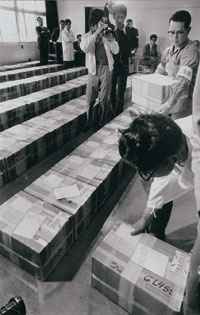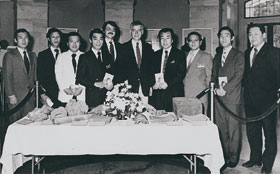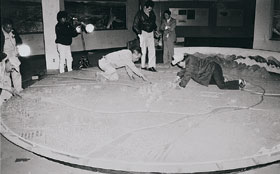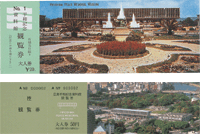1975-1990 A Place to Tell the A-bomb Story
|
Thirty years after the bombing, the leading survivors were aging and A-bombed buildings were being demolished, one after the next.
The Peace Memorial Museum was deteriorating, as evidenced by its leaking roof and rusting iron frame. A makeover was needed to protect the artifacts and materials on display.
The first major renovation was carried out from 1973 to 1975. Around this time, photos showing A-bomb damage returned to Hiroshima from the U.S. Newly discovered artifacts and drawings by A-bomb survivors enhanced the museum's collection and its ability to communicate the A-bomb experience.
The annual number of museum visitors reached one million in 1971. Amplified by growing numbers of school excursion tours, this figure topped 1.5 million in 1989. The percentage of foreign visitors has remained constant at roughly 5%.
The museum has taken on the role of combating the fading of the A-bomb memory while serving as a vital base in the struggle for world peace.
|
 |
 |
 |

23*Material returned from the U.S.
May 10, 1973
Medical Records and Specimens Center of the Research Institute for Radiation Biology and Medicine of Hiroshima University (now, International Radiation Information Center of the Research Institute for Radiation Biology and Medicine of Hiroshima University)
Courtesy of Chugoku Shimbun
Immediately after the war, the US military took many A-bomb-related materials back to the US. In 1973, at the request of Japan, those materials were returned. Among them were 1,879 photos showing the tragic conditions in Hiroshima immediately after the bombing. These photos quickly became central to the exhibits, on a par with belongings of the victims. This photo shows staff members of the Medical Records and Specimens Center of the Research Institute for Radiation Biology and Medicine of Hiroshima University unpacking returned materials.
|
|

22*A first step toward preservation of artifacts
August to September 1975 Hiroshima Peace Memorial Museum
This is the museum after the renovation overhauled the exhibits to make the atomic bombing easier to understand. Wax figures were created to illustrate the conditions at the time. Shades were hung to block the light that was fading the artifacts, and a new preservation repository was added. Until this time, the museum had simply exhibited A-bomb artifacts. Now it began working seriously to preserve them.
 24*Commissioning belongings
24*Commissioning belongings
August 6, 1979 Hiroshima Peace Memorial Museum
Courtesy of Chugoku Shimbun
Letting go of belongings left behind by loved ones is hard to bear. However, one by one, such belongings are presented to the Museum by donors who think, "If it can help convey the tragedy of atomic bombing...." This photo shows three mothers weeping in front of a hat, a school uniform, a belt and some gaiters. The three children killed were Hiroshima Municipal Junior High School students exposed to the bomb while helping to demolish buildings for fire lanes.
|
 |
 |
 |

25*Overseas exhibition of A-bomb materials
June 1980
Washington, D.C. Russell Senate Office Building
Courtesy of Akihiro Takahashi
In 1980, a Hiroshima-Nagasaki Atomic Bomb Exhibition displayed 66 A-bomb photographs and 40 A-bomb artifacts in the Russell Senate Office Building in Washington, D.C. This exhibition sponsored by the Hiroshima Junior Chamber was one of the early overseas exhibitions of A-bomb materials.
|
 |

26*Relocating temporarily for remodeling
1990 Hiroshima Peace Memorial Museum
Courtesy of Chugoku Shimbun
Thirty-five years after opening, the number of visitors was continuing to increase and the inadequate display spaces and other defects of the facility were creating obvious problems. In 1990, the museum was renovated for a second time. The City Auditorium and Peace Memorial Hall, built concurrently with the museum, were also renovated. This photo shows the third-generation model panorama being reassembled after removal to a temporary display space during the renovation. Today, this model is displayed at Honkawa Elementary School.
|
|
 |
 |
 |
 |

|
27*Museum admission tickets
When the museum opened, the price of adult admission was 20 yen, with child admission 10 yen. Since the 1972 price rise to 50 yen and 30 yen, respectively, admission fees have remained the same for 33 years. At first glance, the tickets appear the same, but a closer look reveals that the museum and the tickets themselves have altered with the times.
|
|






